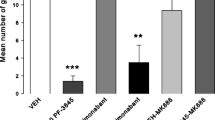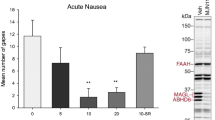Abstract
Rationale
Drugs that block fatty acid amide hydrolase (FAAH, which elevates anandamide [AEA]) and drugs which block monoacylglycerol (MAGL, which elevates 2-arachidonyl glycerol [2-AG]) have promise in treating both acute and anticipatory nausea in human patients.
Objective
This study aims to evaluate the relative effectiveness of dual MAGL/FAAH inhibition with either alone to reduce acute and anticipatory nausea in rat models.
Materials and methods
AM4302, a new dual MAGL/FAAH inhibitor, was compared with a new selective MAGL inhibitor, AM4301, and new selective FAAH inhibitor, AM4303, for their potential to reduce acute nausea (gaping in taste reactivity) and anticipatory nausea (contextually elicited conditioned gaping) in two rat models.
Results
Our in vitro studies indicate that AM4302 blocks human and rat FAAH: IC50 60 and 31 nM, respectively, with comparable potencies against human MAGL (IC50 41 nM) and rat MAGL (IC50 200 nM). AM4301 selectively blocks human and rat MAGL (IC50 8.9 and 36 nM, respectively), while AM4303 selectively inhibits human and rat FAAH (IC50 2 and 1.9 nM), respectively. Our in vivo studies show that the MAGL inhibitor, AM4301, suppressed acute nausea in a CB1-mediated manner, when delivered systemically or into the interoceptive insular cortex. Although the dual FAAH/MAGL inhibitor, AM4302, was equally effective as the FAAH inhibitor or MAGL inhibitor in reducing acute nausea, it was more effective than both in suppressing anticipatory nausea.
Conclusions
Dual FAAH and MAGL inhibition with AM4302 may be an especially effective treatment for the very difficult to treat symptom of anticipatory nausea.







Similar content being viewed by others
References
Alapafuja SO, Nikas SP, Bharathan IT, Shukla VG, Nasr ML, Bowman AL et al (2012) Sulfonyl fluoride inhibitors of fatty acid amide hydrolase. J Med Chem 55:10074–10089
Andrews PL, Horn CC (2006) Signals for nausea and emesis: implications for models of upper gastrointestinal diseases. Auton Neurosci 125:100–115
Contreras M, Ceric F, Torrealba F (2007) Inactivation of the interoceptive insula disrupts drug craving and malaise induced by lithium. Science 318:655–658
Cross-Mellor SK, Ossenkopp KP, Piomelli D, Parker LA (2007) Effects of the FAAH inhibitor, URB597, and anandamide on lithium-induced taste reactivity responses: a measure of nausea in the rat. Psychopharmacol 190:135–143
Fegley D, Gaetani S, Duranti A, Tontini A, Mor M, Tarzia G, Piomelli D (2005) Characterization of the fatty acid amide hydrolase inhibitor cyclohexyl carbamic acid 3′-carbamoyl-biphenyl-3-yl ester (URB597): effects on anandamide and oleoylethanolamide deactivation. J Pharmacol Exp Ther 313:352–358
Foubert J, Vaessen G (2005) Nausea: the neglected symptom? Eur J Oncol Nurs 9:21–32
Folch J, Lees M, Sloane Stanley GH (1957) A simple method for the isolation and purification of total lipids from animal tissues. J Biol Chem 226:497–509
Hickok JT, Roscoe JA, Morrow GR, King DK, Atkins JN, Fitch TR (2003) Nausea and emesis remain significant problems of chemotherapy despite prophylaxis with 5-hydroxytryptamine-3 antiemetics: a University of Rochester James P. Wilmot Cancer Center Community Clinical Oncology Program Study of 360 cancer patients treated in the community. Cancer 97:2880–2886
Hornby PJ (2001) Central neurocircuitry associated with emesis. Am J Med 11(Suppl 8A):106S–112S
Limebeer CL, Abdullah R, Rock EM, Imhof E, Wang K, Lichtman AH, Parker LA (2014) Attenuation of anticipatory nausea in a rat model of contextually-elicited conditioned gaping by enhancement of the endocannabinoid system. Psychopharmacol 231:603–612
Limebeer CL, Hall G, Parker LA (2006) Exposure to a lithium-paired context elicits gaping in rats: a model of anticipatory nausea. Physiol Behav 88:398–403
Limebeer CL, Krohn JP, Cross-Mellor S, Litt DE, Ossenkopp KP, Parker LA (2008) Exposure to a context previously associated with nausea elicits conditioned gaping in rats: a model of anticipatory nausea. Behav Brain Res 187:33–40
Limebeer CL, Rock EM, Mechoulam R, Parker LA (2012) The anti-nausea effects of CB1 agonists are mediated by an action at the visceral insular cortex. Br J Pharmacol 167:1126–36
Morrow GR, Roscoe JA, Hickok JT, Andrews PR, Matteson S (2002) Nausea and emesis: evidence for a biobehavioral perspective. Support Care Cancer 10:96–105
Parker LA (2014) Conditioned flavor avoidance and conditioned gaping: rat models of conditioned nausea. Eur J Pharmacol 722:122–133
Parker LA, Niphakis R, Downey R, Limebeer CL, Rock EM, Sticht MA, Morris H, Abdullah R, Lichtman A, Cravatt B (2014) A new MAGL inhibitor, MJN110, reduces acute and anticipatory nausea in rats and vomiting in Suncus murinus. Psychopharmacology 232:583–93
Parker LA, Rock EM, Limebeer CL (2011) Regulation of nausea and vomiting by cannabinoids. Br J Pharmacol 163:1411–1422
Patricelli MP, Lashuel HA, Giang DK, Kelly JW, Cravatt BF (1998) Comparative characterization of a wild type and transmembrane domai-deleted fatty acid amide hydrolase: identification of the transmembrane domain as a site for oligomerization. Biochemistry 37:15177–87
Ramarao MK, Murphy EA, Shen MW, Wang Y, Bushell KN, Huang N et al (2005) A fluorescence-based assay for fatty acid amide hydrolase compatible with high-throughput screening. Anal Biochem 343:143–151
Rock EM, Limebeer CL, Mechoulam R, Piomelli D, Parker LA (2008) The effect of cannabidiol and URB597 on conditioned gaping (a model of nausea) elicited by a lithium-paired context in the rat. Psychopharmacol 196:389–395
Rock EM, Limebeer CL, Ward JM, Cohen A, Grove K, Niphakis MJ, Cravatt BF, Parker LA (2015) Interference with acute nausea and anticipatory nausea in rats by fatty acid amide hydrolase (FAAH) inhibition through a PPARα and CB1 receptor mechanisms respectively in a double dissociation. Psychopharmacol 232:3841–48
Roscoe JA, Morrow GR, Hickok JT, Stern RM (2000) Nausea and vomiting remain a significant clinical problem: trends over time in controlling chemotherapy-induced nausea and vomiting in 1413 patients treated in community clinical practices. J Pain Symptom Manage 20:113–121
Sharkey KA, Darmani NA, Parker LA (2014) Regulation of nausea and vomiting by cannabinoids and the endocannabinoid system. Eur J Pharmacol 722:134–146
Sticht MA, Limebeer CL, Abdullah RA, Poklis JL, Niphakis M, Rafla BF, Ho W, Cravatt BF, Sharkey KA, Lichtman AH, Parker LA (2012a) Effects of exogenous endocannabinoid administration and pharmacological inhibition of endocannabinoid catabolic enzymes in the visceral insular cortex on acute nausea-induced conditioned gaping in rats. Neuropharmacology 102:92–102
Sticht MA, Limebeer CL, Rafla BR, Parker LA (2015) Intra-visceral cortex 2-arachidonoylglycerol, but not N-arachidonoylethanolamide suppresses acute nausea-indcued conditioned gaping in rats. Neuroscience 286:338–44
Sticht MA, Long JZ, Rock EM, Limebeer CL, Mechoulam R, Cravatt BF, Parker LA (2012b) The MAGL inhibitor, JZL184, attenuates LiCl-induced vomiting in the Suncus murinus and 2-AG attenuates LiCl-induced nausea-like behaviour in rats. Br J Pharmacol 165:2425–2435
Tuerke KJ, Limebeer CL, Fletcher PJ, Parker LA (2012) Double dissociation between regulation of conditioned disgust and taste avoidance by serotonin availability at the 5-HT3 receptor in the posterior and anterior insular cortex. J Neurosci 32:13709–13717
Williams J, Wood J, Pandarinathan L, Karanian DA, Bahr BA, Vouros P et al (2007) Quantitative method for the profiling of the endocannabinoid metabolome by LC-atmospheric pressure chemical ionization-MS. Anal Chem 79:5582–5593
Wiskerke J, Irimia C, Cravatt BF, De Vries TJ, Schoffelmeer AN, Pattij T, Parsons LH (2012) Characterization of the effects of reuptake and hydrolysis inhibition on interstitial endocannabinoid levels in the brain: an in vivo microdialysis study. ACS Chem Neurosci 3:407–417
Zvonok N, Pandarinathan L, Williams J, Johnston M, Karageorgos I, Janero DR et al (2008a) Covalent inhibitors of human monoacylglycerol lipase: ligand-assisted characterization of the catalytic site by mass spectrometry and mutational analysis. Chem Biol 15:854–862
Zvonok N, Williams J, Johnston M, Pandarinathan L, Janero DR, Li J et al (2008b) Full mass spectrometric characterization of human monoacylglycerol lipase generated by large-scale expression and single-step purification. J Proteome Res 7:2158–2164
Acknowledgments
This research was supported by a grant from the Natural Sciences and Engineering Research Council (92056) to LAP, Canadian Institute of Health Research (137122) to LAP, and National Institute of Health to AM and MAK Scientific LLS (2R44DA023737) to S0A.
Author information
Authors and Affiliations
Corresponding author
Rights and permissions
About this article
Cite this article
Parker, L.A., Limebeer, C.L., Rock, E.M. et al. A comparison of novel, selective fatty acid amide hydrolase (FAAH), monoacyglycerol lipase (MAGL) or dual FAAH/MAGL inhibitors to suppress acute and anticipatory nausea in rat models. Psychopharmacology 233, 2265–2275 (2016). https://doi.org/10.1007/s00213-016-4277-y
Received:
Accepted:
Published:
Issue Date:
DOI: https://doi.org/10.1007/s00213-016-4277-y




